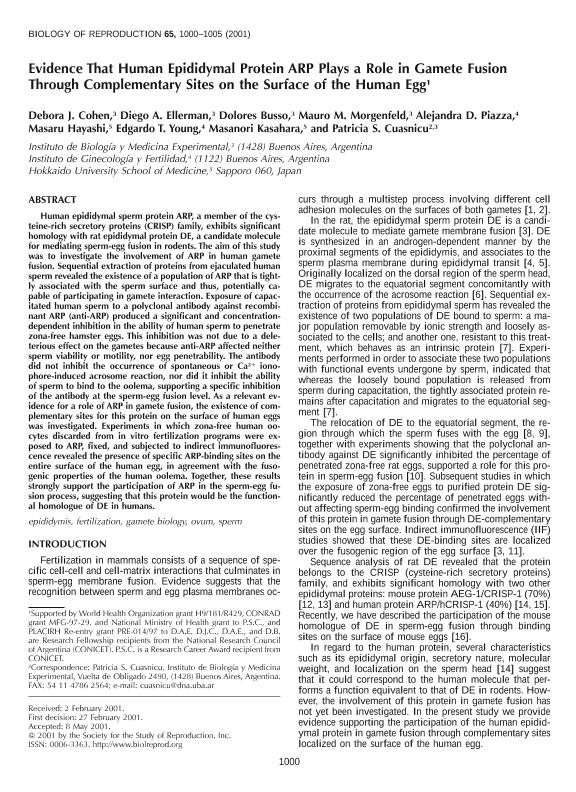Mostrar el registro sencillo del ítem
dc.contributor.author
Cohen, Debora Juana

dc.contributor.author
Ellerman, Diego Andrés

dc.contributor.author
Busso, Dolores
dc.contributor.author
Morgenfeld, Mauro Miguel

dc.contributor.author
Piazza, Alejandra D.
dc.contributor.author
Hayashi, Masaru
dc.contributor.author
Young, Edgardo

dc.contributor.author
Kasahara, Masanori
dc.contributor.author
Cuasnicu, Patricia Sara

dc.date.available
2017-12-22T05:25:11Z
dc.date.issued
2001-05
dc.identifier.citation
Cuasnicu, Patricia Sara; Kasahara, Masanori; Young, Edgardo; Hayashi, Masaru; Piazza, Alejandra D.; Morgenfeld, Mauro Miguel; et al.; Evidence that human epididymal protein ARP plays a role in gamete fusion through complementary sites on the surface of the human egg; Society for the Study of Reproduction; Biology of Reproduction; 65; 4; 5-2001; 1000-1005
dc.identifier.issn
0006-3363
dc.identifier.uri
http://hdl.handle.net/11336/31337
dc.description.abstract
Human epididymal sperm protein ARP, a member of the cysteine-rich secretory proteins (CRISP) family, exhibits significant homology with rat epididymal protein DE, a candidate molecule for mediating sperm-egg fusion in rodents. The aim of this study was to investigate the involvement of ARP in human gamete fusion. Sequential extraction of proteins from ejaculated human sperm revealed the existence of a population of ARP that is tightly associated with the sperm surface and thus, potentially capable of participating in gamete interaction. Exposure of capacitated human sperm to a polyclonal antibody against recombinant ARP (anti-ARP) produced a significant and concentration-dependent inhibition in the ability of human sperm to penetrate zona-free hamster eggs. This inhibition was not due to a deleterious effect on the gametes because anti-ARP affected neither sperm viability or motility, nor egg penetrability. The antibody did not inhibit the occurrence of spontaneous or Ca(2+) ionophore-induced acrosome reaction, nor did it inhibit the ability of sperm to bind to the oolema, supporting a specific inhibition of the antibody at the sperm-egg fusion level. As a relevant evidence for a role of ARP in gamete fusion, the existence of complementary sites for this protein on the surface of human eggs was investigated. Experiments in which zona-free human oocytes discarded from in vitro fertilization programs were exposed to ARP, fixed, and subjected to indirect immunofluorescence revealed the presence of specific ARP-binding sites on the entire surface of the human egg, in agreement with the fusogenic properties of the human oolema. Together, these results strongly support the participation of ARP in the sperm-egg fusion process, suggesting that this protein would be the functional homologue of DE in humans.
dc.format
application/pdf
dc.language.iso
eng
dc.publisher
Society for the Study of Reproduction

dc.rights
info:eu-repo/semantics/openAccess
dc.rights.uri
https://creativecommons.org/licenses/by-nc-sa/2.5/ar/
dc.subject
Epidymis
dc.subject
Fertilization
dc.subject
Gamete Biology
dc.subject
Ovum
dc.subject
Sperm
dc.subject.classification
Biología Reproductiva

dc.subject.classification
Ciencias Biológicas

dc.subject.classification
CIENCIAS NATURALES Y EXACTAS

dc.title
Evidence that human epididymal protein ARP plays a role in gamete fusion through complementary sites on the surface of the human egg
dc.type
info:eu-repo/semantics/article
dc.type
info:ar-repo/semantics/artículo
dc.type
info:eu-repo/semantics/publishedVersion
dc.date.updated
2017-12-04T17:55:20Z
dc.identifier.eissn
1529-7268
dc.journal.volume
65
dc.journal.number
4
dc.journal.pagination
1000-1005
dc.journal.pais
Estados Unidos

dc.description.fil
Fil: Cohen, Debora Juana. Consejo Nacional de Investigaciones Científicas y Técnicas. Instituto de Biología y Medicina Experimental. Fundación de Instituto de Biología y Medicina Experimental. Instituto de Biología y Medicina Experimental; Argentina
dc.description.fil
Fil: Ellerman, Diego Andrés. Consejo Nacional de Investigaciones Científicas y Técnicas. Instituto de Biología y Medicina Experimental. Fundación de Instituto de Biología y Medicina Experimental. Instituto de Biología y Medicina Experimental; Argentina
dc.description.fil
Fil: Busso, Dolores. Consejo Nacional de Investigaciones Científicas y Técnicas. Instituto de Biología y Medicina Experimental. Fundación de Instituto de Biología y Medicina Experimental. Instituto de Biología y Medicina Experimental; Argentina
dc.description.fil
Fil: Morgenfeld, Mauro Miguel. Consejo Nacional de Investigaciones Científicas y Técnicas. Instituto de Biología y Medicina Experimental. Fundación de Instituto de Biología y Medicina Experimental. Instituto de Biología y Medicina Experimental; Argentina
dc.description.fil
Fil: Piazza, Alejandra D.. Instituto de Ginecología y Fertilidad; Argentina
dc.description.fil
Fil: Hayashi, Masaru. Hokkaido University School of Medicine; Japón
dc.description.fil
Fil: Young, Edgardo. Instituto de Ginecología y Fertilidad; Argentina
dc.description.fil
Fil: Kasahara, Masanori. Hokkaido University School of Medicine; Japón
dc.description.fil
Fil: Cuasnicu, Patricia Sara. Consejo Nacional de Investigaciones Científicas y Técnicas. Instituto de Biología y Medicina Experimental. Fundación de Instituto de Biología y Medicina Experimental. Instituto de Biología y Medicina Experimental; Argentina
dc.journal.title
Biology of Reproduction

dc.relation.alternativeid
info:eu-repo/semantics/altIdentifier/url/http://www.bioone.org/doi/abs/10.1095/biolreprod65.4.1000
dc.relation.alternativeid
info:eu-repo/semantics/altIdentifier/doi/http://dx.doi.org/10.1095/biolreprod65.4.1000
dc.relation.alternativeid
info:eu-repo/semantics/altIdentifier/url/https://www.ncbi.nlm.nih.gov/pubmed/11566719
Archivos asociados
